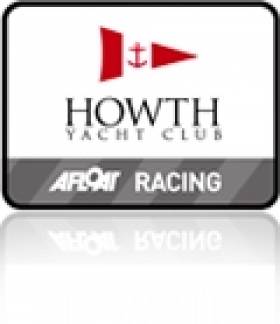Displaying items by tag: Howth Yacht Club
Howth Yacht Club Boats Dominate Malahide Regatta
#malahide – Malahide Yacht Club's annual cruiser regatta, sponsored by SPAR, attracted 24 boats in three classes who sailed two back-to-back races on courses set by PRO Neil Murphy in light southerly to south-easterly breezes.
Class 2 and 3 did windward-leeward courses while the White Sail class completed Olympic triangle courses and the day saw visiting Howth boats top the table in each class on both handicaps.
Class 2 was headed by Impetuous (Noonan & Chambers) from Sunburn (Ian Byrne) in 2nd and MYC's XtraTime (Michael & Paul Arthurs) 3rd.
Vincent Gaffney's Alliance II had two race wins to take the Class 3 honours, ahead of Blue Jay (MYC Youth Team) on ECHO and Scandal (Brian McDowell) on IRC. Scandal was 3rd on ECHO and Goyave (Russell Camier) was 3rd on IRC.
The White Sails division saw a comfortable overall win by David Sargent's Indulgence ahead of Toughnut (Simon Revill) and Spellbound (Graham Burrows).
#sportsgrants – Two of Ireland's biggest yacht clubs shared top awards in a €500,000 payout to 16 Irish Sailing Clubs in the Government's Sports Capital Programme announced last week. The full list of beneficiaries is below.
Dublin's Howth Yacht Club and National Yacht Club both got €77,000 in the Governments main vehicle for supporting the development of sports facilities and the purchase of non-personal sports equipment.
National Yacht Club Commodore Larry Power says his Dublin Bay club, one of the top six yacht clubs in the country, 'is privileged to receive this high level of funding from the Sports Capital Programme'. Power says the money will be spent on an upgrade of club boats to 'enhance the NYC status as a local community club in Dun Laoghaire'.
In Howth, Commodore Brian Turvey says the north Dublin Club 'intends to use this valuable and most welcome grant on the development of keelboat sailing', youth academy and HYC's own 'introduction to sailing' programme.
The Minister of State for Tourism & Sport Michael Ring announced grants of €40.5 million for 880 sports projects across the country last week, sailing getting a small share in the divvy up. The Sports Capital Programme is the Government's main vehicle to distribute funds. The facilities being funded range from small-scale equipment grants, to regionally significant centres of sporting excellence.
2014 Sports Captial Grant Allocations
Crookhaven Harbour Sailing Club € 32,000.00
Glandore Harbour Yacht Club € 12,000.00
Clontarf Yacht and Boat Club € 29,063.00
Dublin Bay Sailing Club € 23,778.00
Howth Sailing and Boating Club € 33,635.00
Howth Yacht Club € 77,000.00
Malahide Yacht Club € 44,149.00
Sailing in Dublin € 25,000.00
Skerries Sailing Club € 10,552.00
Swords Sailing and Boating Club € 11,646.00
National Yacht Club € 77,902.00
Tralee Bay Sailing Club € 20,000.00
Wexford Harbour Boat and Tennis Club € 56,000.00
Blessington Sailing Club € 24,000.00
Bray Sailing Club € 18,000.00
Greystones Sailing Club € 9,000.00
#420 - Howth Yacht Club's Robert Dickson and Sean Waddilove remain dominant in the 420 class nationally following their convincing first-place performance at the 420 Connachts last weekend.
It was a double podium finish for the North Co Dublin club, too, as Ewan McMahon and Colin O'Sullivan placed third out of the 16 entries that raced in "perfect sailing weather" off Spiddal in Galway Bay.
Howth Yacht Club has more on the story HERE.
#hyc – Three well known Irish half tonners make the journey to Saint Quay Portrieux in Brittany for the Half Ton Classic Cup representing Howth Yacht Club. The Evan's brothers "The Big Picture", Jonny Swan and Jim Freyne's "Harmony" and Dave Cullen's "King One" will all head in search of trophies in this highly competitive class event which is expecting 32 entries.
Following a total refurb and optimisation and following her recent second place in the ICRAs, Michael and Richie Evan's beautiful MG30 will hope to repeat her form to try and clinch the top trophy. A sister ship to the current holder, Nigel Biggs; Checkmate, these two boats should provide some very close racing for the spectators.
Harmony, incidentally a previous Half Ton Classic Cup champion in 2007 when owned by Nigel Biggs, could be a dark horse and is still one of the fastest half tonners around. Now looking fantastic following a refit, she may suffer a little from lack of time on the water.
King One makes its third trip to the Continent in an effort to take the prize. Placing third in 2009, lying second in 2011 when she broke her mast and lying 4th last year when a black flag ruined any chances, she has some unfinished business!.
The Half Ton Classic Cup, sponsored by Euro Car Parks, kicks off with a practice race on Monday followed by 11 races to be held up to Friday next.
You can follow the event here
#etchells – Consistency is king and Bill Hardesty and crew of Stephanie Roble, Taylor Canfield and Marcus Eagan have earned the 2014 Etchells World Championship by sticking to a steady plan for success. Ireland's title bid, that included an eighth place in race three, was cut short after the sole Irish entry in the 90–boat fleet. Howth's Burrows family, sailing Bedrock, only completed the first five of the nine race series in New York. Full results here.
Hardesty's plan was formulated 6 months ago, when he put together his young team consisting of Match Race World Champion Taylor Canfield and top women's match racer Stephanie Roble—25-year-olds eager to dedicate themselves to a worthy goal. Add in top trimmer Marcus Eagan and the team was complete.
After a tough series in Miami last winter, Hardesty made the decision to train in his home waters of San Diego where he had top talent and similar conditions to the worlds venue in Newport. "Tom Carruthers, Vince Brun and Bruce Nelson helped us up our game through sail testing and boat tuning," Hardesty said. But they didn't focus solely on boat speed. "We worked on evaluating risk management to make good decisions, define it, buy into it and follow through; that all came together at this regatta and helped with our consistency."
Hardesty further commented that having three elite match racers on board "gave us an advantage at the start through our time and distance timing and laylines, which made starting easier and more comfortable. We only had one bad start, that was the race we finished 20th."
Commenting on his third Etchells World title, Hardesty said: "This was one of the toughest to win; the level of sailing was at its highest. But it's very exciting. I love the class, I love the boat."
Winning the last race was Peter Duncan, who had local ties. "We didn't sail a particularly great series," said Duncan. "Our expectations were certainly higher, so this was great to end on a high note, which is better than the alternative." Duncan's crew included former world champion Jud Smith and Thomas Blackwell.
Ante Razmilovic, Chris Larson and Stuart Flinn finished second overall, with 2013 world champion Marvin Beckman, Steve Hunt and Ezra Culver in third.
Competitors will look forward to the 2015 Etchells Worlds which will be held in Hong Kong, hosted by the Royal Hong Kong Yacht Club, November 1 to 7, 2015.
Final Top-10 Results
Place, Sail Number, Boat Name, Skipper, Hometown, Race 1, Race 2, Race 3, Race 4, Race 5, Race 6, Race 7, Race 8, Race 9, Total (not including worst score)
1. USA 979, Line Honors, Bill Hardesty, San Diego, 2-2-20-1-4-5-13-15-96/DNC 62.0
2. HKG 1333, Swedish Blue, Ante Razmilovic, London, U.K., 3-6-8-44-14-19-3-31-13 97.0
3, USA 1378, The Martian, Marvin Beckmann, Houston, 8-3-11-5-15-46-32-7-19 100.0
4. USA 1308, KGB, Senet Bischoff & Ben Kinney, Larchmont, N.Y. 10-20-25-52-1-31-2-9-15 113.0
5. USA 1372, Aretas, Skip Dieball, Beaver Dam, Wis., 38-13-4-19-7-17-1-61-23 122.0
6. CAN 1396, Hank Lammens, Norwalk, Conn., 1-8-1-12-16-7-47-49-42 134.0
7. AUS 1383, Triad, John Bertrand, South Yarra, Australia, 4-10-5-28-27-23-53-43-2 142.0
8. USA 1376, Arethusa, Phil Lotz, Newport, R.I., 9-18-6-96/BFD-52-9-12-37-8 151.0
9. USA 1137, La Tormenta, Shannon Bush, Refugio, Texas, 26-16-31-37-6-21-6-16-66 159.0
10. USA 1404, Lifted, Jim Cunningham, San Francisco, 42-4-32-40-50-3-4-25-10 160.0
J24 Crew Win Howth Yacht Club's Inaugural Sportsboat Cup
#hyc – Howth Yacht Club's new Sportsboat initiative attracted J24s, J80s and the visiting 1720 European championships for its first outing last weekend.
Well known cJ24 skipper Flor O’Driscoll and the crew of his J24 Hard On Port were the deserving overall Sportsboat Cup winners for 2014 and were awarded the Romaine Cagney Trophy.
Impressively, they did not count a result worse than second for the regatta and won half of the races. The popular winners have been stalwarts of the J24 class in Ireland who also have won several IRC titles in the well campaigned boat. They were only delighted to be taking another piece of silverware out of the Pale to Munster.
The cup was sailed in three days of glorious sunshine and light winds. Suncream and water were some of the most important parts of all crews’ kit every day as temperatures were consistently over 20 degrees. Water was especially important after many of the competitors were burning the midnight oil each evening. Racing was successfully completed on Sunday which incorporated the 1720 Europeans, the J24 Easterns and the Sailfleet J80s. The race officers did exceptionally well to get the full schedule of races completed on both race courses without any delays. The challenging conditions and a big shift meant that the last race of the day on Saturday for the 1720s had to be abandoned to avoid it becoming a lottery. PRO Derek Bothwell’s mantra that “It is better to have no race than a bad race” was a wise one. In any case, there was ample time to make it up on Sunday morning to get all eight races in.
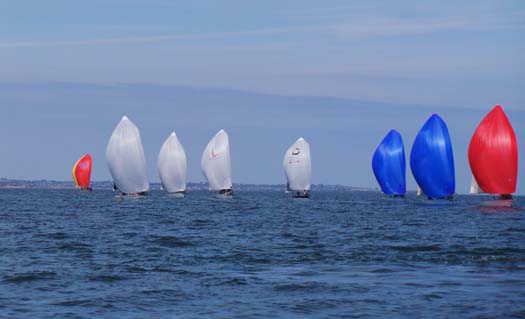
1720s made a welcome return to HYC after over a decade of absence
The 1720 Europeans came down to the wire and was decided in the last race to by the slimmest of margins. After a match race with Denis Murphy’s Aquatack in the last race, Peter O’Leary’s Jacobs Bar emerged victorious by just half a point overall to defend his title from last year. Not far behind the leading pair was a surprise performance from Kenneth Rumball on INSC.ie who rounded out the podium places. Maybe the Dun Laoghaire based team should travel to the events more frequently and the rest of the Dublin based fleet will too. The top performer from outside of Ireland came from Tom Forrestor-Coles and his crew from the south coast of the UK who finished fourth, just two points off the podium.

1720 winners. Pictured Adam Hyland, Cathal Cottrell, Peter O’Leary, Jamie Donegan & Youen Jacob
O’Learys title defence was impressive as earlier this year the boat was in a sorry state after being abandoned for years in a field in Baltimore. Left under a tree with the hatch open the boat was covered in leaves, dirt and the hull was full of water. Before they began the resurrection Cathal Cottrell even joked “We thought of entering the boat in the Chelsea flower show instead of the Europeans when we found her, and we nearly did”. After only rigging a new mast on Thursday night and splashing for the first time early Friday morning, they got off to a relatively slow start but definitely got into their rhythm on Saturday and hauled in Aquatack before conclusion on Sunday. Seventeen year old Adam Hyland was a welcome addition to the crew and O’Leary praised the young talent in his acceptance speech.

Eoin O’Fearghail
When the wind dropped on Saturday for the J24s and J80s racing was as rapid as Elephant Polo. The wind direction chopped and changed to the point where PRO Richard Kissane decided to abandon and restart Race 2. Whereas it didn't suit those doing nicely at the time, it was the sensible decision. The restarted race got away smartly in a bit more breeze allowing the fleet to get all scheduled races under their belts and home in time for tea and tiffin....and after-sun!
Sunday's racing was brought forward an hour to test those who were out the night before. A few cups of Blue Nun did nothing to slow up Flor O'Driscoll and his team who put in a stellar Sunday performance.
Lough Swilly's "Bandit" lived up to its name by putting in a sweet port tack start in Race 5. Open-jawed, the rest of the fleet took some time catching!
Overnight leader Stefan Hyde on Hamilton Bear had a wobbly start to the day but finished off the weekend with a well deserved bullet. In the last they weren’t able to push Hard On Port down the fleet enough in the last to snatch the overall title at the death, so it was second overall for them. Howth Yacht Club’s Under 25 Keelboat Team on Eurocarparks Kilcullen rounded out the podium in third place.
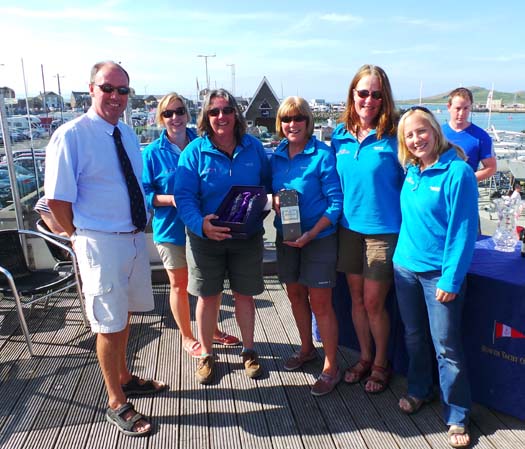
J80 winners. Joan Harris, Gillian Guinness, Elaine Taylor, Sally Watson & Linda Darbey
In the Sailfleet J80 class Gillian Guinness and her ladies team took the title ahead of Mossy Shanahan. In the closely fought class young Ewan McMahon finished a close third. With most of the fleet trading blows Gillian and her crew were very consistent and eked out a lead which meant they had the series wrapped up with a race to spare. There were even sightings of wine and other delights on the sail home each day on board. The bulk of the fleet from second to fifth place were separated by only four points. Exactly what you want and expect from such evenly matched one design racing.
Howth would like to thank all the competitors who made the event as good as it was and Edward Dillon who generously sponsored some prizes. We hope to have everyone back and even more classes involved when we run the event again in 2016.
Full Results here: http://hyc.ie/results
Ireland's Oldest Wooden Boats Aren't Getting Any Younger
#woodenboats – On Midsummer's Day, W M Nixon looks back on the already busy and event-filled Irish season of 2014, and reflects on the extraordinary longevity of some boats, their remarkable variety, and the diverse characters who own them.
When I shipped aboard the former Bristol Channel Pilot cutter Madcap to sail the Old Gaffers Division in Howth Yacht Club's Lambay Race on June 7th, it wasn't the first time I'd been out and about on a boat built in the 1870s. But as most of my experiences on John and Sandra Lefroy's 1873-vintage iron-built classic 58ft Victorian steam yacht Phoenix on Lough Derg took place in the 1970s with the most recent jaunt being way back in 1982, sailing on the Madcap was indeed the first time afloat in a boat built 140 years ago.
It takes an effort to get your head around the most basic notion of such an age. You find yourself reflecting on the delights that still awaited the human race at the time, things that were still far into the remote future in the 20th Century. During the 1870s, industrialisation was still gaining traction, but the very idea of warfare on the industrial scale which was to be experienced in the Great War of 1914-18 was beyond most people's imagination, and way beyond anyone's experience. That said, there were more than enough other ways of experiencing an early death, with a range of particularly unpleasant illnesses which have been largely eliminated today.
Yet it was increasing industrialisation which created the circumstances that enabled both boats to be built. The Bristol Channel Pilot cutters evolved rapidly in the latter half of the 19th Century in order to provide pilots for the more numerous and increasingly large ships which were coming into ports such as Cardiff and Bristol. They reached their peak of performance around 1900, by which time they'd achieved a remarkable stage of development, being fast and able, yet comfortable at sea, and capable of being handled by a very small crew after the pilots had been delivered to incoming vessels. When their working days were over as they were replaced by motorised vessels, they proved ideal as seagoing cruising yachts.
There was nothing work-oriented about the pleasure yacht Phoenix when she was built to the designs of Andrew Horn in Waterford in 1873. Or maybe that's being a bit naïve. After all, she is down as having been built by and for the Malcolmsons of Waterford. They were a remarkable clan who brought many industries to Waterford in the 19th Century, and they created the miniature industrial town of Portlaw westward from the city, off the south bank of the Suir Estuary.
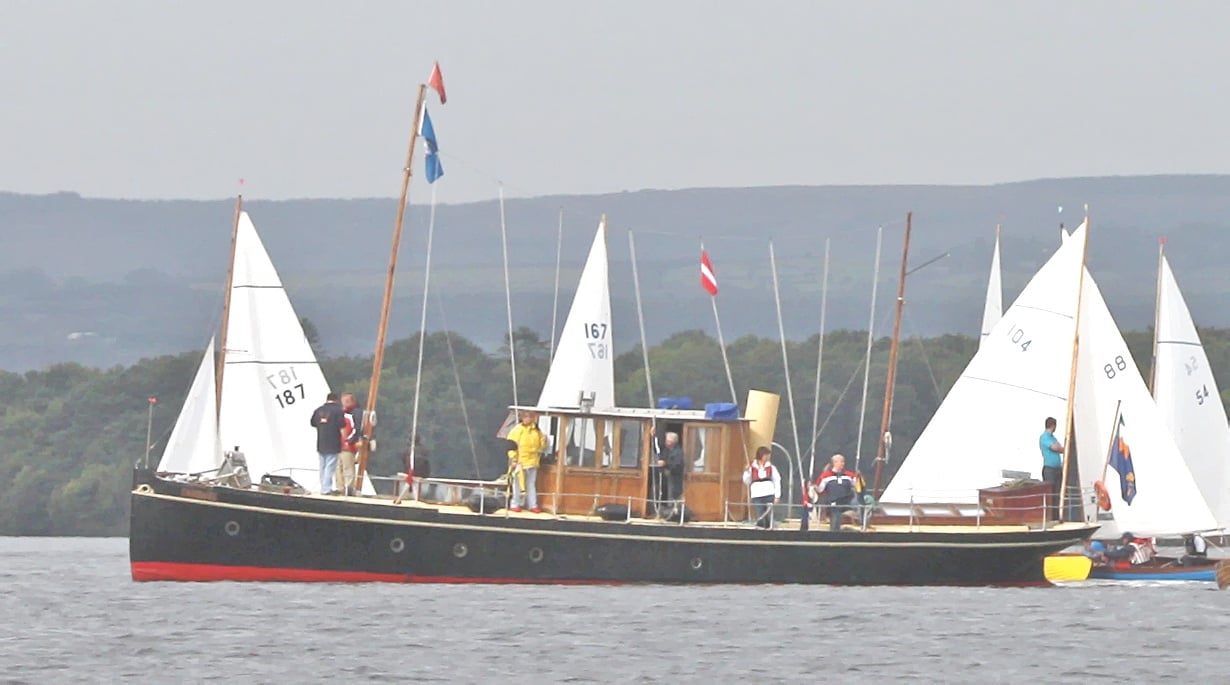
The 58ft Phoenix, iron-built in Waterford in 1873, performing Committee Boat duties at Dromineer for Lough Derg YC. Photo: Gerardine Wisdom
So in building the Phoenix themselves, so to speak, they were creating a subtle advertisement for Waterford expertise, with this new miniature of an ocean liner being constructed in the highly-regarded Lowmoor iron. And she's a powerful statement - this lovely old vessel has lasted much better than many of the Waterford enterprises which outshone her at the time of her building, so much so that if, in Waterford's current recessional woes, they sought something to symbolise what the city is capable of, they would do worse than put some resources the way of the Phoenix for her continuous maintenance.
Five years ago she made a very stylish appearance as the Committee Boat in a classics regatta at Dromineer, and that in turn produced an astonishing photo which included Ian Malcolm's 1898-built Howth 17 Aura. It was the first time a jackyard topsail had been seen on Lough Derg since before the Great War, and all that together with a raft of Shannon One Designs (which date from 1922 onwards) and a fleet of Dublin Bay Water Wags from 1902 onwards meant that the total age of the boat in the photo was pushing towards the 2,000 years mark.

Phoenix and the 1898 Howth 17 Aura (Ian Malcolm) at Dromineer with rafts of Shannon ODs and Water Wags. The combined age of the bots in the photo is well over a thousand years. Photo: Gerardine Wisdom
To be aboard Phoenix is to be transported right back to the 1870s, as she has a beam of only 10.5ft, which on a length of 58.5ft make for one very slim and potent hull. She has long since had her original steam engine replaced with a diesel, and back in 1982 when I was last afloat in her, it was October, and we were the Committee Boat for the annual IYA Helmsmans Championship, raced that year in Shannon One Designs with Dave Cummins of Sutton the winner, crewed by Gordon Maguire.
Being late season, the Phoenix's injectors needed a clean, but as the Race Officers were those perpetual schoolboys Jock Smith and Sam Dix of Malahide, they were delighted by the Phoenix's ability to emit a fine plume of smoke from her funnel at full speed, and after the championship was resolved they tore across the lively waters of Autumnal Lough Derg at full speed while – from another boat - I grabbed some photos which made Phoenix look like a destroyer in action at the Battle of Jutland. One of them subsequently appeared as the cover of Motor Boat & Yachting, and as I seem to have mislaid the colour slides, if anyone has a copy of that particular edition I'd much appreciate a scan of it.
Moving on from the 1873-built Phoenix in 1982 to the 1874-built Madcap in 2014 is quite some saga, but we'll edit it by sticking to events this year revolving around the developing annual Old Gaffer programme in the Irish Sea. Last year Dickie Gomes' 1912-built 36ft John B Kearney yawl Ainmara from Strangford Lough won the inaugural Leinster Trophy race in Dublin Bay which marked the OGA's Golden Jubilee, and she did it despite now being bermuda rigged. But as she was returning to her birthplace in Ringsend for the first time in 90 years, she was treated as an honorary gaffer.
Honour being the theme of things, this meant we were honour-bound to bring her south again to defend the Leinster in 2014, but this was given an added impetus by a plan to link up in Dun Laoghaire with Martin Birch's 1902-built Espanola out of Preston in Lancashire. From 1912 until 1940, the 47ft Espanola was a feature of the Royal Irish YC in Dun Laoghaire, owned by noted sailor Herbert Wright, who in 1929 became the founding Commodore of the Irish Cruising Club when he cruised Espanola with four other yachts to Glengarriff where the ICC was founded on July 13th 1929. The Espanola links, together with the fact that the RIYC is now in partnership with Wicklow Sailing Club in hosting the fleet for the biennial Round Ireland Race, made for a fortuitous combination, as Dickie Gomes of Ainmara was Mr Round Ireland between 1986 and 1993, when he held the open Round Ireland Record and also had been overall winner of the 1988 race.

Espanola as she was in 1929, when Commodore's yacht at the founding of the Irish Cruising Club
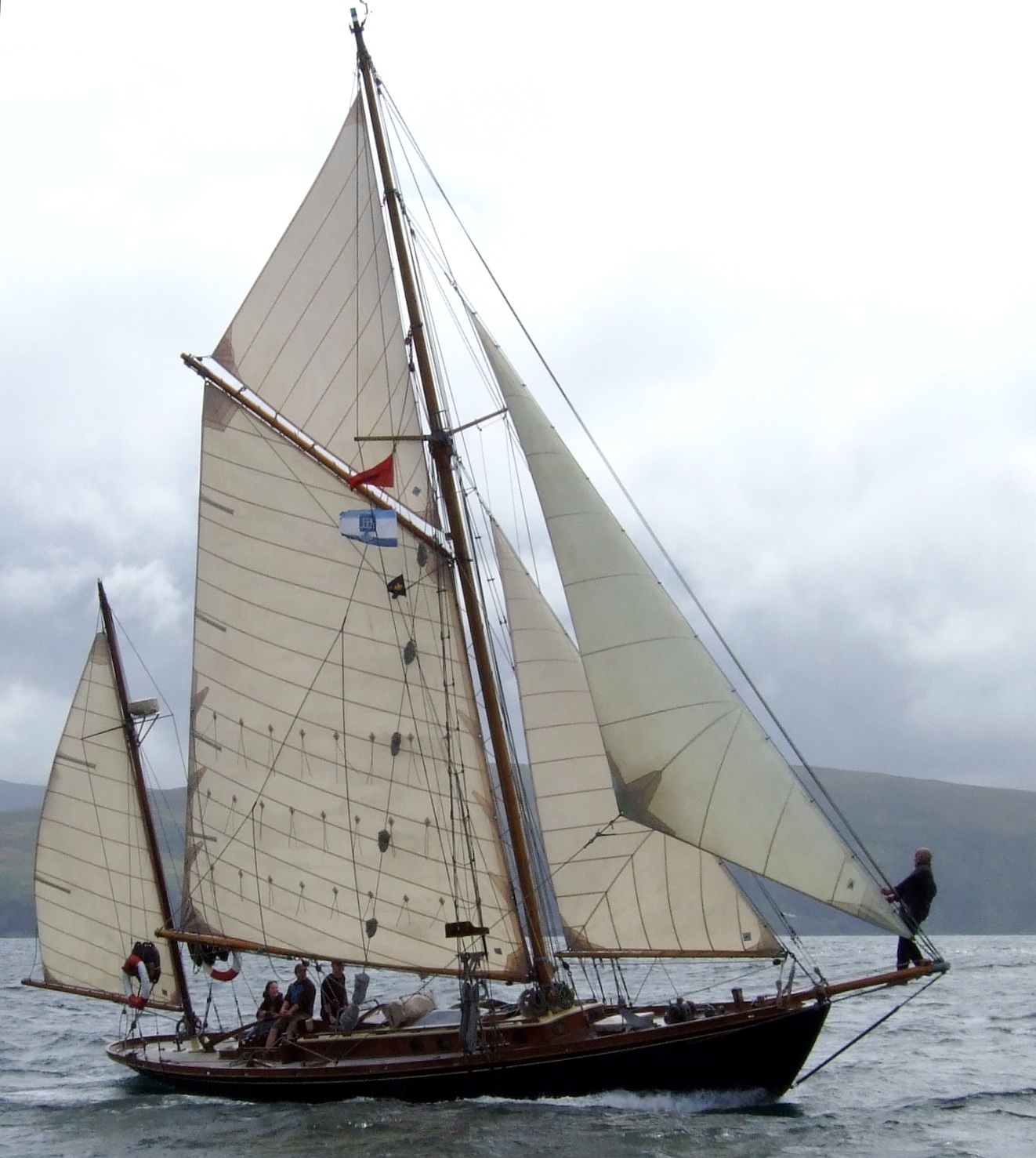
The 1902-built Espanola as she is today
Thus all the stars were in alignment for an historic and convivial meeting of the two old boats at the RIYC on the evening of Friday May 30th, the night before the Leinster Plate race was due to start just round the corner in Scotsmans Bay. But while stars may have been in alignment, ducks failed to get into a row, as Espanola with her exceptional draft of 7ft 6ins failed to get out of Preston over the shallow bar in the one tide which would have suited, on May 16th.
This situation is a useful illustration of the problems the old gaffer people face in keeping the show on the road with limited resources. Martin Birch, having been a lecturer in Lancaster University, had found Preston's little marina an ideal place to keep and maintain Espanola, and the marina in turn regarded the old girl as their pet boat. But Preston is longer a busy commercial port, so the channel has been left to is own devices, and with the huge tides of the Lancashire coast, getting Espanola to sea is quite a challenge as sometimes there's only one day in any month when it can be done.
So there we were, faced with the prospect of Hamlet without the Prince with just ten days to go to the historic gathering at the RIYC. But Jim Horan, affable Commodore of the Royal Irish YC, took it all in his stride and told us to bring Ainmara along anyway, it would be a good excuse for a Friday night party and he was keen to meet the skipper who had made the Round Ireland challenge very much his own 28 years ago.
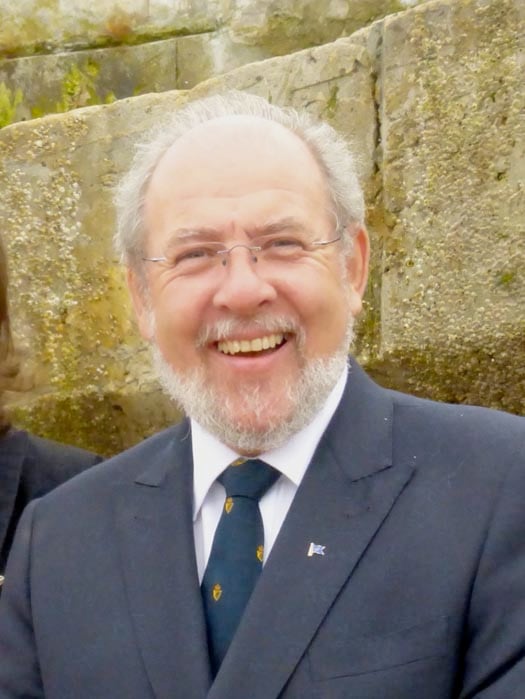
Jim Horan, Commodore of the RIYC, told us to come on and be welcome even though Espanola couldn't make it. Photo: W M Nixon
With the foul weather of mid-May, while Ainmara had got afloat from her winter quarters in a hayshed at the Gomes farm on the Ards peninsula in County Down, further fitting out was difficult in endless rain, and the skipper came down with a massive cold. But then the weather perked up, and he did too, so at lunchtime on Thursday My 29th we headed down Strangford Lough from the Down Cruising Club's former lightship headquarters at Ballydorn to catch the start of the ebb in Strangford Narrows at 1430 hrs.
Progress was good with a light to moderate nor'easter, but Ainmara and her crew (there were four of us – Brian Law, Ed Wheeler and I together with Dickie) have got to the stage where nights at sea are regarded to be the result of bad cruise planning. Yet if we were going to be comfortably in Dun Laoghaire for Friday evening, then only Port Oriel at Clogherhead made sense as an overnight. But Port Oriel, home to some of the best-maintained fishing boats on the coast, can become a very crowded place on a Thursday night.
However, a phone call to the uncrowned king of Clogherhead Aidan Sharkey – whom I'd first met back in the 1980s when our two boats were moored in Seal Hole at Lambay, where he was diving on the nearby 1854 wreck of the Tayleur - ensured there'd be a berth for us, and when we arrived in at sunset there was the man himself to direct us to a corner where we wouldn't inconvenience fishing boats, and moreover had access to a set of proper steps.
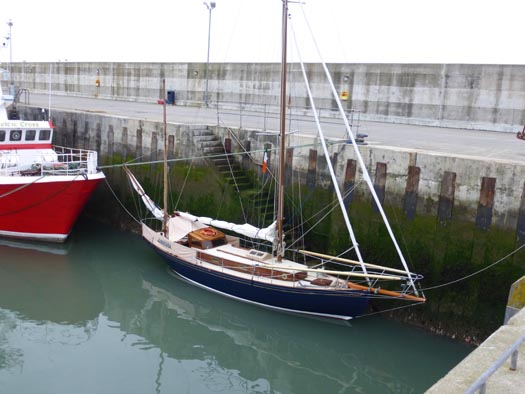
Port Oriel at Clogherhead provided Ainmara wih a handy overnight stop. There was more space available (below) as most of the 30-strong local fleet were away fishing the south coast. Photos: W M Nixon

Aidan's commitment to the maritime life is total. He's of an old Clogherhead fishing family, and he and his late brother Feargal were the backbone of the local beach-launched lifeboat crew. The banter was mighty on board Ainmara, leavened with tales of lifeboat experience which would curl your hair. The laughter through the companionway attracted others board, and soon Sean the razor clam man (all of his catches go straight to China) was in the hatchway with glass in hand, and when we asked where we might get a new deck scrub first thing in the morning as somehow the ship's own one had gone AWOL, Sean said not to worry, he'd throw one on board, and we could just leave it on the big fishing boat beside us as we left next day.
Ashore, I went up to Aidan's house in the village as he'd said he'd something to show me, which was an understatement. He was into the diving much earlier than most, thus when he got to wrecks which today are known to everyone, there were still intact bits of the cargo to be salvaged. Most east coast divers have fragments of chinaware, pottery and other artefacts from the Tayleur, but Sean had so many complete pieces, together with many other items of special antique value from other wrecks mostly in Donegal, that he would be well able to provide complete afternoon tea for the entire choir, all served on 1840s china. But it wasn't tea I got in the Sharkey household, it was Aidan's present of a large bag of fresh crab claws, and a selection of his own-cured salmon – smoked and gravid lax both – which sustained us through the next day's sail.
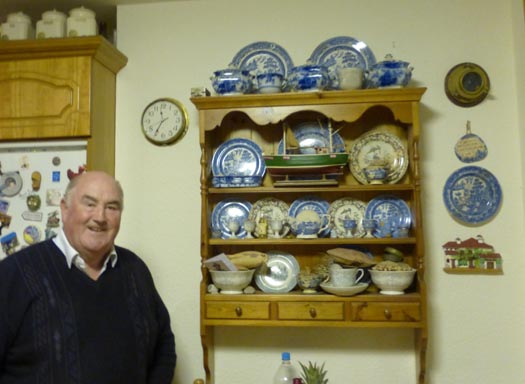
Aidan Sharkey of Clogherhead with some of his remarkable collection of salvaged chinaware. Photo: W M Nixon

The sort of sailing cruising folk dream of. Ainmara shaping up nicely to take the first of the fair tide through the islands at Skerries. Photo: W M Nixon
The morning brought the welcome gift of a decent little sunny east to nor'east breeze, and a lovely beam reach all the way down to Dublin Bay, with the south-going tide caught to perfection at the Skerries islands (and yes, I know it's superfluous to talk of the "Skerries islands", but that's what they're called to differentiate them from the Skerries off Holyhead).
Anyone who was involved in last weekend's ICRA Nationals at the Royal Irish YC will know how this premier club can lay on the welcome with effortless style. In the last weekend of May, Ainmara and her crew had the Royal Irish treatment all to themselves. Sailing Manager Mark McGibney ushered us to the prime berth right at the club where we found ourselves in a miniature maritime museum, with the Quarter Tonner Quest close astern (she was to become the ICRA National Champion a fortnight later), while just across the way was the S&S 36 Sarnia – back in 1966, the Sisk family set Irish sailing alight by bringing this very up-to-the-minute fin-and-skeg fibreglass boat back from builders Cantiere Benello in Italy, where they'd started series production on this ground-breaking Olin Stephens design before the same hull shape became better known as the Swan 36 built by Nautor in Finland.
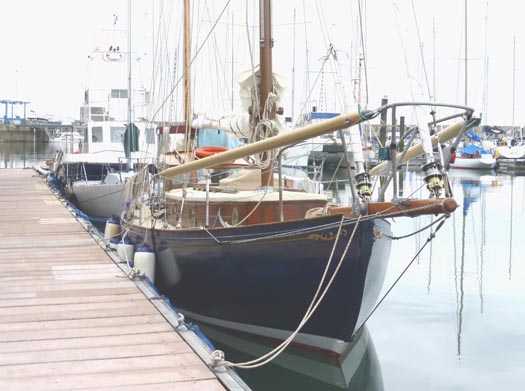
"Maritime museum" at the Royal Irish YC. Ainmara (built Ringsend 1912) with the 1987 Quarter Tonner Quest astern, and the 1966-built S&S 36 Sarnia across the way in her marina berth. Photo: W M Nixon
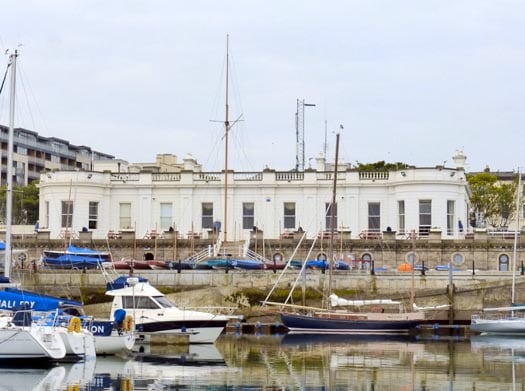
It has to be one of the best berths in the world. Ainmara at the RIYC – it's early morning, and the flags aren't yet hoisted. Photo: W M Nixon
The hospitality flowed seamlessly as the late afternoon graduated into evening and then velvet night. Ainmara is an extraordinarily effective calling card, and the stream of entertaining visitors brought laughter aboard before the Commodore moved us all up to the clubhouse and a fine supper and much chat with Michael O'Leary, one of the most visionary minds in Irish sailing, and his wife Kate and her people with tales of how she and longtime friend Clare Hogan are in the thick of things in the very healthy Water Wag class.
The RIYC took all this in its stride despite the fact that there was a big wedding going in the clubhouse at the same time, but it all went so smoothly that at one stage Ainmara's crew found themselves being invited to join in the wedding celebrations. However, we demurred because we were athletes in training for the Leinster Trophy next day, yet nevertheless certain key players in the wedding got themselves aboard Ainmara at a very late hour.
The plan for Saturday had been changed, but we were right up to speed with this as Denis Aylmer, the RIYC's key man in the OGA, had told us over a convivial pint that the likelihood of light winds had meant that Race Officer John Alvey had moved the scene of the action from Scotsmans Bay to a more compact race area close off the entrance to Dublin Port. It was all grist to our mill, as we could make an early morning departure and head up to Poolbeg Y & BC across a mirror-like bay, lining up the crew to salute the North Bank Lighthouse in the River Liffey, as it's something of a memorial to John B Kearney, whose day job was in the engineering department in Dublin Port and docks. With his original lighthouse, he pioneering a technique of screwing the piles into the seabed. You'd have thought an air of reverence would prevail, but with Ainmara's crew of anarchists, straight faces could only be maintained for about 12 seconds.
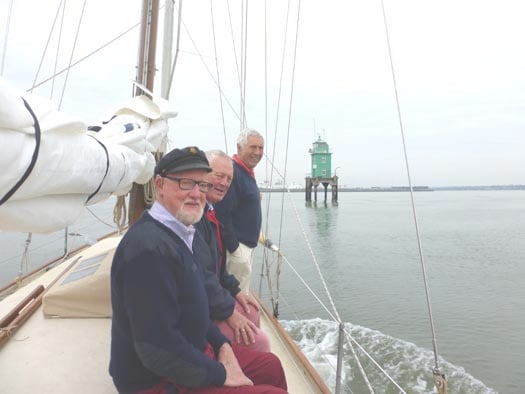
Trying to look appropriately reverential. Ed Wheeler, Brian Law and Dickie Gomes approaching Dublin Port's North Bank Lighthouse on which John B Kearney pioneered the use of screw piles. Photo: W M Nixon

"We're only here for the breakfast". Katy O'Connor's excellent catering in Poolbeg Y & BC is deservedly popular among visiting crews. Photo: W M Nixon
While we wanted to be well on time for the pre-race briefing, the main reason for getting promptly to Poolbeg was to take full advantage of Katy O'Connor's legendary breakfast at the club, and we put away enough calories to keep us going all day. At the briefing, John Alvey told us the committee were concerned that the very varied fleet – everything from Ainmara to the big Naomh Cronan, a superb Clondalkin-built re-creation of a Galway Hooker – included some boats which, in the light airs expected, could be out on the bay until nightfall.
So the plan was for a short race taking in several marks so that it could be finished at the end of any leg. But by the time we got down to Dublin Bay, it was crisp blue with a smart little sea breeze filling in to give sailing conditions which suited Ainmara to perfection, yet some of the heavier gaffers were still lumbering slowly about in what to them was a light wind.
They may have been lumbering about, but several were very determined to make a sharp start right on the committee boat. Anyone accustomed to quick-turning and fast-accelerating modern boats will find a fleet of traditional and classic gaffers a real education. They take time to get moving, they take for ever to stop, you point them a long way out, and their bowsprits – "dock probes" as marina managers call them – seem intent on skewering everyone else.
But while our skipper may pretend to be just an old cruising man these days, his racing blood was up. We set ourselves to sweep into what we hoped would be a gap starting to appear at the committee boat seconds after the start signal. We consoled ourselves with the thought that in extremis, we might just manage to shoot head to wind leaving the committee boat to port, ruining our start perhaps, but preserving the Ainmara intact.
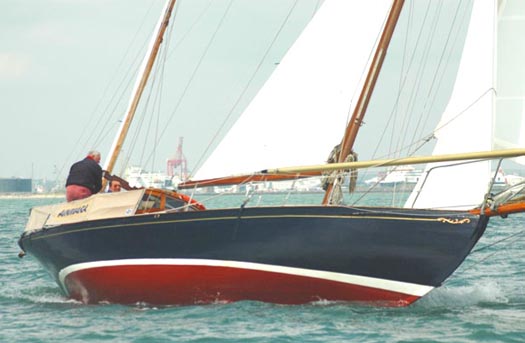
"Go for it, and let's hope there's a gap when we get there..." Ainmara starts to build speed towards her start in the Leinster Trophy Race 2014 . Photo: Gill Mills
So she was set at it, despite attempts to slow her a bit the speed built up, but as quickly as I'm telling this the gap started to appear and she zapped into it and just managed to keep her wind clear on Sean Walsh's remarkably fast Heard 28 Tir na nOg and Denis Aylmer's Mona. Now we had to find the DBSC marks in the right sequence, but Ed was on top of it feeding co-ordinates and giving out courses, we found that with a bit of luck we might just lay the first mark close hauled, and though Tir na nOg – whose waterline length is much the same as Ainmara's – hung in very well, he'd to tack for the mark while we scraped by it, so after that it was up jib tops'l and making hay.
But though we took line honours, we felt certain Tir na nOg would win on corrected time, as a Heard 28 sailed as well as she is can be one very potent performer, and Sean seemd to be still right on our stern at the finish. The results wouldn't be announced until Monday evening, so that Saturday afternoon we wandered back upriver to Poolbeg in sunshine so powerful that an afternoon zizz was your only man, and then we emerged on deck to find that others were arriving in port, with one of the the Welsh visitors, the engine-less Happy Quest from Milford Haven, making a copy-book job of berthing under sail, and then all was alive with the Howth Seventeens arriving in from their home port after a very close-fought passage race which had been narrowly won by Conor Turvey sailing Isobel.

Happy Quest from southwest Wales lives up to her name with a successful berthing under sail only at Poolbeg. Photo: W M Nixon
The Seventeens were there to put on a display race next day (Sunday) in the Liffey as part of the three day Dublin Port Riverfest over the Bank Holiday weekend. Inevitably for those of us who took part in the first one in 2013 when the OGA Golden Jubilee was top of the bill, there wasn't quite the same buzz, but first-timers watching aboard the restaurant ship Cill Airne assured us they found it very exciting indeed, and were especially impressed by the waterborne ballet of the two big harbour tugs Shackleton and Beaufort, while the funfairs and entertainment shows along the quays really did provide something for everything.
Once again the very sight of the Seventeens – which we in Howth tend to take for granted – was fascinating in the city setting. Though the promise of a decent breeze evaporated, Race Officer Harry Gallagher managed to get enough in the way of results to declare Peter Courtney with Oonagh the winner, an appropriate result for an historic class making a show performance, as the Courtneys have been involved with the Howth Seventeens since 1907.
I watched it all from an appropriate setting, aboard the Dutch Tall Ship Morgenster, a handsome 150ft brig which should be required visiting for anyone promoting the idea of a new Tall Ship for Ireland. For the Morgenster – which was re-configured as a sailing ship in 2009 – is run as a commercial venture, and can pay her way through being the right size to be a business proposition, helped by being based in the Netherlands. Thus she has a vast continental catchment area nearby to attract trainees of all ages and abilities who are prepared to pay enough for berths to keep the show efficiently on the road. There are several Dutch-based tall ships run in the same way, and the message is that if you're going to make a go of it commercially, you have to have a large enough and readily-accessed market to make it viable, and you need a boat big enough to carry sufficient trainees relative to the size of the ship – 36 in Morgenster's case – to balance the books.
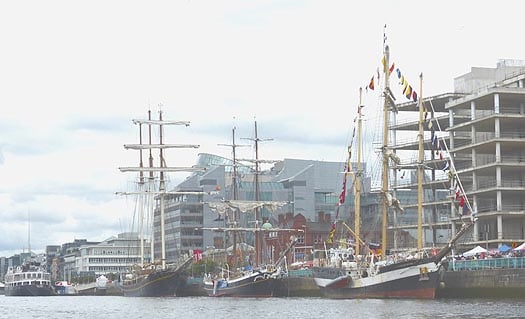
Tall ships in the Liffey, with the commercially-run 150ft sail training big Morgenster at centre. Photo: W M Nixon
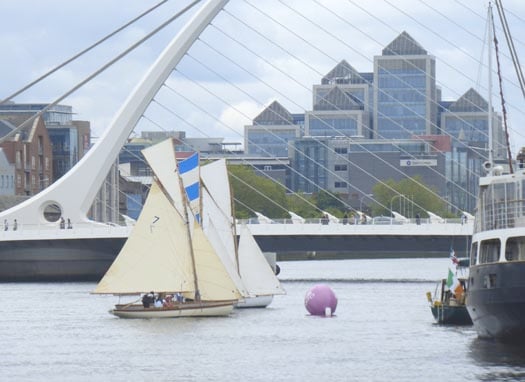
Sails and the city – Howth 17s at the Sam Beckett bridge Photo: W M Nixon
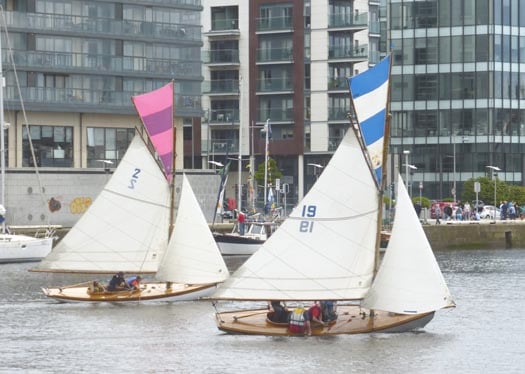
There was just enough wind for the first race for the Howth 17s to show what they could do in the Liffey if the breeze held up. Photo: W M Nixon
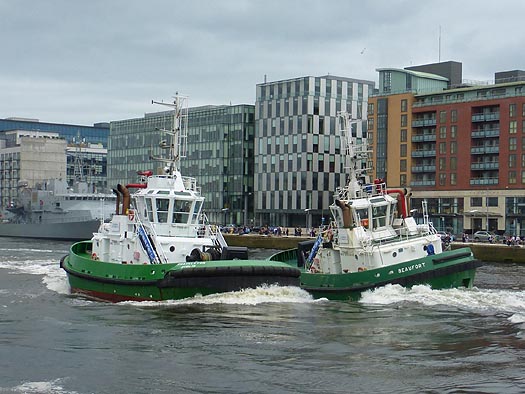
The Dublin Port tugs have awesome power to deploy in their waterborne "ballet" Photo: W M Nixon
But enough of solemnity. We went downriver again for farewells at Poolbeg, and then away across Dublin Bay and round the Baily for a seafood feast in Howth at the new place Crabby Jo's, and a handy overnight stop before using a good westerly next morning to give us a push towards Ardglass where we needs must stop, as the tides into Strangford Lough are a door slammed shut every six hours. But as ever, Ardglass's convenient and friendly little marina provided the perfect decompression chamber, and up in Mulherron's the crack was mighty with the crew of the famous restored Manx longliner Master Frank, just the two of them with skipper Joe Pennington - aka The Rat – being crewed by a psychiatrist who claimed to be strictly on holiday, but we did wonder, as any gathering of Old Gaffers is better than a wardful of nutters.
Ainmara's mini-voyage concluded next day with a text message from Dublin to tell us we'd retained the Leinster Trophy, which surprised us, and then with an idyllic sail in a sunny sou'wester, everything set to the jib tops'l, and all sail carried right through The Narrows, across Strangford Lough and thorough Ringhaddy Sound, and on across a blue sea among green islands past tree covered shores until we handed the sails just off the entrance to Down Cruising Club's isle-girt outer anchorage immediately south of Mahee Island, in a little sheltered area which has somehow acquired the unlovely name of Pongo Bay.

Home again. Ainmara back on her mooring in Strangford Lough, with Brian Law's classic yawl Twilight astern. Photo: W M Nixon
There, Ainmara is securely moored close to Brian Law's own cruising boat, the beautifully restored classic Lion Class yawl Twilight, designed by Arthur Robb. Like Dickie Gomes, Brian does all his own boatwork in a hayshed beside the house. So closely intertwined are their interests that they readily crew for each other, and of course the exchange of information and assistance and re-fit ideas is continuous.
And there's one further fact about these guys which may be of interest to other cruising crews. Aboard Ainmara during the three seasons in which I've cruised on her since she was restored for her Centenary in 1912, there's no kitty to cover expenses. There's an underlying feeling that as the skipper provides the boat, the crew owe him on a permanent basis. Thus if we get into a port and there's a choice between a comfortable marina berth or hanging off a quay wall, the crew will simply slip away and discreetly pay for a marina berth, and then tell the skipper it's a done deal.
Equally, when ashore for a meal, one of the crew will usually sidle off and pay for everyone when no-one else is looking. But if the skipper thinks the day has gone particularly well, you'll sometimes find he's paid for it all himself, As for getting diesel, whoever is carrying the cans will pay for it himself. Then too, when stores are required, it's covered by whoever goes to get them. It all sounds like an accountant's nightmare, yet so far, somehow at the end of the cruise everyone is content with the feeling that it has all balanced out, and as it has worked well for three years and longer, the attitude is that if it ain't broke, then don't try and fix it.
It had been hoped that Ainmara could stay on in the Dublin area for a week to do the Howth YC's Lambay Race in the Old Gaffers division on June 7th, as she won it in 1921. However, there was too much work still to be done to get her completely ready for a busy cruise programme coming rapidly down the line. But as she'll have to be back next year to defend the Leinster Trophy again, who knows but the double event might be done in 2015. As it was, her need for further fitting-out nearer to home was the saving of me, as a mighy temptation arose. The ancient Madcap from the north had stayed on in Dublin Bay, and was doing the Lambay Race with other old gaffers. The word on the waterfront is that Madcap may well be sold to France to be the centrepiece of a maritime museum in La Rochelle. So the Lambay Race might well be the last chance to sail on a 140-year-old boat. A place was secured on board.

The gaffers gather......Tir na nOg, Madcap and Naomh Cronan on misty morning in Howth before the Lambay Race. Photo: W M Nixon
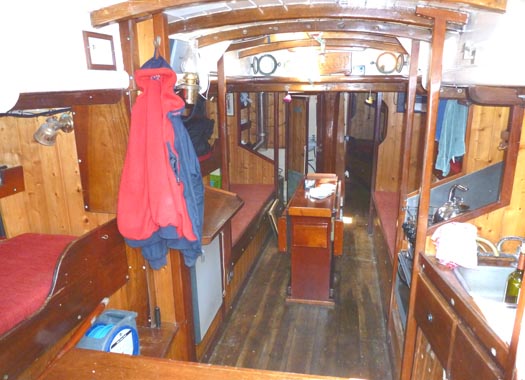
Madcap's sensible accommodation (above and below) reflects the seagoing needs of the pilots for whom she was built140 years ago. Photo: W M Nixon
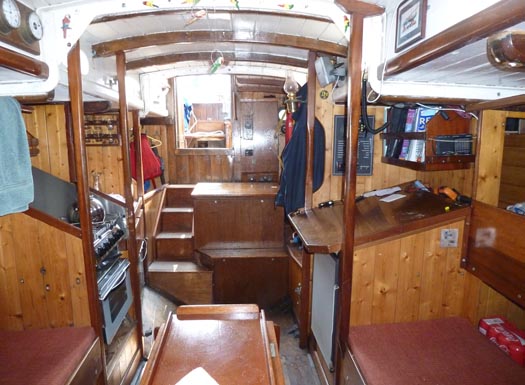
Madcap's owner for more than twenty years now has been Adrian "Stu" Spence, a rugged Belfast barrister who has the essential determination to keep such an ancient boat going. And going places too – he has been to Greenland and several times to Spain and Brittany, and has brought his old cutter through many a problem to log an impressive voyaging record.
If you have a boat of this age, your motto is: When God made time, he made a lot of it. Thus although the Old Gaffer's division was due to start at 1135, five minutes after the Howth Seventeens had set off through Howth Sound to sail the traditional Lambay course leaving Ireland's Eye to starboard and Lambay to port in order to celebrate the centenary of the Lynch family's Howth 17 Echo, it was pushing 1140 by the time we mde our leisurely debut to follow other other gaffers, which had Sean Walsh's keenly-sailed Tir na nOg soon disappearing into the misty asterly, followed by the Galway hooker Naomh Cronan helmed by the great Paddy Murphy of Renvyle, the Cornish crabber Alice (Mark Lynch) and then Madcp in her own good time.
With Northern Ireland Old Gaffers Association President Peter Chambers on the helm, Madcap settled gently into her stride, showing that she needs very little steering – she'll maintain a straight line for miles without the wheel being touched or secured in a any way. It's an oddly soothing characteristic, just the thing to calm a man down after a hectic week in the High Court, and she soon was making her own best speed with a bit of bite now in the breeze, putting Alice astern and keeping Naomh Cronan handily in touch.

"Is it always this foggy off Howth?" Stu Spence and Peter Chambers with he visibility closing in during the Lambay Race. Photo: W M Nixon
The mist became fog, but as ever it was difficult to tell just how thick it was until we suddenly found ourselves surrounded by wraiths in the gloom. It was Class 0 racing towards Lambay, and overtaking us just feet away, giving dramatic close-ups of some of the most likeable boats on the East Coast, with Stephen O'Flaherty's Spirit 54 Soufriere pacing it with Chris Hourican's First 47.7 Pretty Polly and the Tyrrell family from Arklow with their handsome J/122 Aquelina.
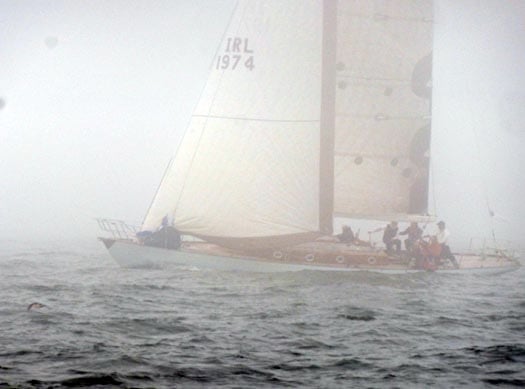
Do not adjust your sets, it really was this foggy for a while. Stephen O'Flaherty's Spirit 54 Soufriere in the fog during the Lambay Race Photo: W M Nixon

Chris Hourican's First 47.7 Pretty Polly in close-up Photo: W M Nixon
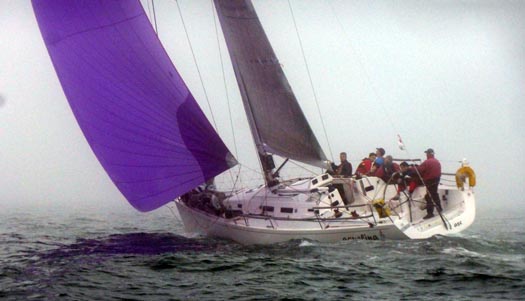
The Tyrrell family's J/122 Aquelina looking her best as she slices through the fog. Photo: W M Nixon
The fog was lifting as we got to the island with boats everywhere – the gaffermen were most impressed. Naomh Croanan had been overtaken, and Peter found us the perfect track along the flukey north side of Lambay, with Madcap effortlessly sliding over the smooth sea on a dead run and apparently consolidating her position.
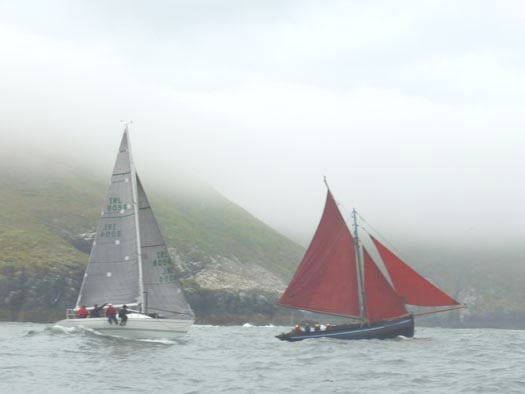
The fog start to lift. Dave Cullen's Half Tonner King One and te Naomh Cronan pproaching the east point of Lambay. Photo: W M Nixon
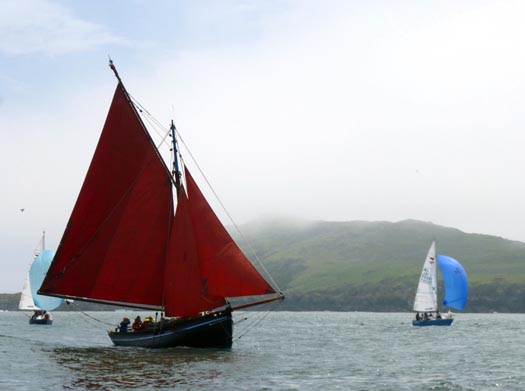
It could be Connemara...., .Naomh Cronan and two Puppeteer 22s off the north coast of Lambay Photo: W M Nixon

The long haul to the finish, the sun is out, and the breeze is beginning to develop enough power to suit Madcap. Photo: W M Nixon
But that was only until we started to head south back to the finish in Howth Sound. The Bermudan boats could lay it, so could the Seventeens, but poor old Madcap was even outpointed by Naomh Cronan, which Paddy Murphy very skilfully kept inside the line of foul tide in Lambay Sound and began to nibble at our lead, while we sagged to lee.
The sun was out, the sailing was lovely, we were surrounded by bustling classes of Puppeteer 22s and Ruffians 23s, and I suggested that a bit more tension in the jib luff, might do the trick, only to be told that as the bowsprit was no more than a liberated telegraph pole, it wasn't really up to the loads which would be put on it by trying to maximise the performance of a 22-ton boat, and nobody wanted splinters flying every which way aboard a boat where the mainboom looked to weigh at least half a ton.
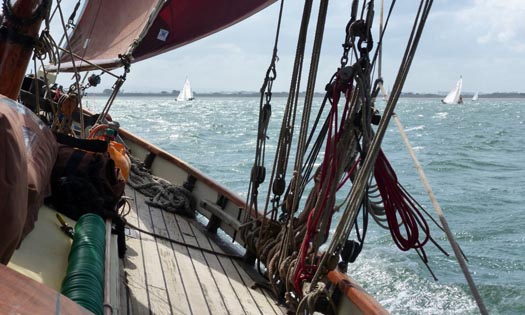
A bite to the breeze, with little boats everywhere – and all of them on starboard. Photo: W M Nixon

The Dun Laoghaire Ruffian 23s made a weekend of it for the Lambay Race, coming over on the Friday night, partying mightily, and then going out to race on Saturday in a rising breeze. Photo: W M Nixon
As it is the loads becme quite something as the breeze freshened sunny and squally down the north flank of the hjill of Howth. By the time we made it across the line, Madcap was going well on smooth water under just mainsail and staysail. But though Naomh Cronan was still ahead and rightly delighted with themselves at getting a good second, it was Tir na nOg which had been in race of her own. Yet as Sean Walsh reported with astonishment, he hadn't been able to get among the slippy little Howth 17s, where John Curley and Marcus Lynch had a good win with Rita, Howth Seventeen No. 1.
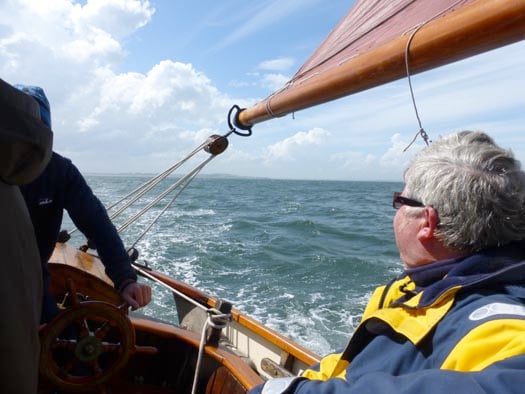
Finally there was enough breeze for Madcap's wake to stretch satisfyingly astern while she could point better with the jib brought in, but Naomh Cronan still finished ahead to take second prize. Photo: W M Nixon

The mighty helmsman of Renvyle. Paddy Murphy (left) steered Naomh Cronan to an excellent performance in the Lambay Race 2014. With him is DBOGA Hon Sec Gerry Murtagh with a trophy he won racing round Lambay in 1986. Photo: W M Nixon
It seemed an Old Gaffers Classic Lambay Race had been inaugurated, and Sean Walsh, international President of the OGA, was most appropriately the first winner. It was something to celebrate, and it duly was, in the sunshine at Howth YC. But in time, I had to take myself away and go for a long walk with the little dog along the beach. For when you've been sailing on a 140-year-old boat, there's a need to ponder the passing years, and this crazy sport of ours in which museum pieces are part of the action.
#cruiserracing – The opening day of the ICRA Nationals at the Royal Irish YC in Dun Laoghaire offered W M Nixon the chance of a painless transition through Friday 13th, and the discovery that there is a life after spinnakers.
In the complete absence of any completely new boats in the hundred-plus lineup for the Irish Cruiser Racing Association's three day Nationals on Dublin Bay, it made sense to focus instead on the lovingly maintained and upgraded veterans in the fleet by sailing on a boat which has been an important part of the Irish sailing story since 1979.
The 30ft Club Shamrock Demelza (she's named after the heroine of a long-forgotten TV drama series based in Cornwall) was one of ten or so boats which raced as a hyper-keen almost one design class in Crosshaven in the late 1970s and early '80s.
Ron Holland's Shamrock Half Tonner design had been achieving racing success since it appeared in 1975, with Silver Shamrock – skippered by Harold Cudmore with all the usual suspects in the crew – winning the Half Ton Worlds at Trieste in 1976. But although they were able little boats with adequate accommodation – American sailor Stuart Woods crossed the Atlantic single-handed in one – the more clubbable element in Royal Cork persuaded the designer and the builders in Cork that a Shamrock with roomier accommodation made possible by a much larger coachroof, with a shorter cockpit and wheel steering, would better meet the needs of club sailors.
For the more austere racing types, the Club Shamrock which emerged from all these discussions looked to be a frivolous boat for party animals, rather than a serious racing proposition. But it speaks volumes for the basic quality of the Ron Holland hull design that the "comfy party boats" could hold their own very well indeed inshore and offshore, if competently sailed.
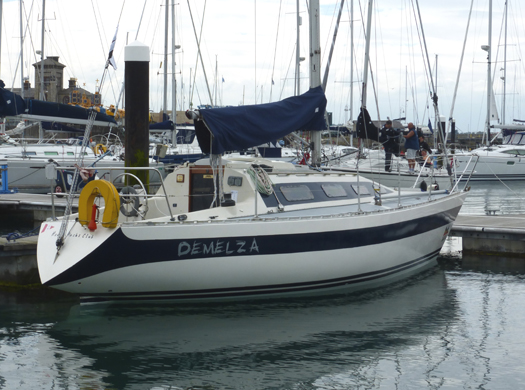
The pintail stern on Demelza makes her very slippy to windward, but her performance suffers on a reach. Photo: W M Nixon
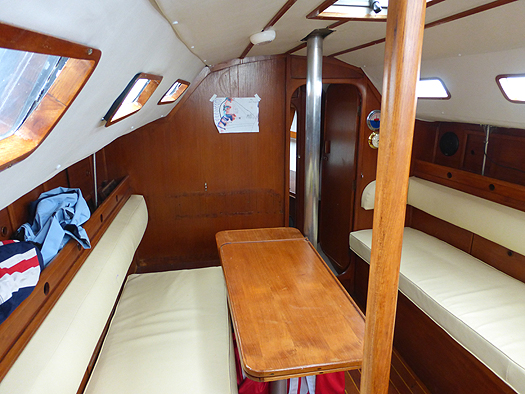
The Club Shamrock version provided a saloon which seemed exceptionally roomy in the 1970s. Photo: W M Nixon
Thus Brian MacManus of Dun Laoghaire, who owned and campaigned Silver Shamrock herself for ten keenly contested offshore seasons in the Irish Sea, remembers that it was the devil's own job getting clear ahead of the almost clunky-looking Club Shamrocks, and it was wellnigh impossible when that Club Shamrock was Demelza, owned and sailed by Neville Maguire.
But we're getting ahead of the story. Back in 1979, Demelza was a new build for Stafford Mansfield of Crosshaven. A key member in his crew was his schoolboy son Mark, later an Olympic sailor and still very much in demand as a frontline helmsman. But back in the late 1970s, it was Demelza which propelled young Mark into the offshore racing game.
He modestly recalls that they won more than their fair share of prizes. But as the boat was raced with complete dedication, there was nothing unfair about their haul of trophies. Eventually, with their sights on the db1 Luv Is, the Mansfields sold Demelza on to Neville Maguire of Howth, thereby bringing another name of international sailing repute into the story, as it was aboard the little boat that Gordon Maguire made early forays offshore.
However, Demelza could win whether Gordon was there or not. In 1984, on the very weekend in August that saw Gordon winning the Irish Windsurfer Nationals in Kerry, in the Irish Sea Neville won the concluding race of the ISORA Championship to take the title – and that in a year in which he had also won his class in the Round Ireland.
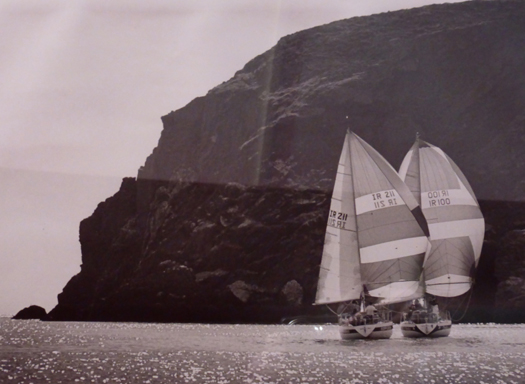
Glued together. Harry Byrne's Club Shamrock Rapparee and Neville Maguire's sister-ship Demelza in one of their many contests during the 1980s, seen here closing in under Howth Head while positioning themselves for the lee mark.
The Club Shamrocks found a new lease of life in Howth, and for many years a feature of the racing there was the continuing battle between the sister Club Shamrocks, Harry Byrne's Rapparee and Neville Maguire's Demelza. They seemed to be glued together in some races, and years afterwards they can still recall every last move afloat, and the final outcome of dozens of contests.
Neville Maguire had long since celebrated his 80th birthday when he sold Demelza to Windsor Laudan and Steffi Ennis for what is only the third ownership in the boat's gilded existence. Steffi Ennis is longtime Howth sailing family, while Windsor is Irish Sea through and through. His boyhood was spent at picturesque Porth Dinnllaen in North Wales, where his parents ran the famous pub on the beach, then when he was 16 they moved to Holyhead and he became so involved in offshore racing that after zillions of crossings of the Irish Sea, he became Howth based.
Demelza is one very lucky little ship, so where better to spend Friday 13th June? In Windsor and Steffi's ownership, she has people who appreciate her good qualities, which are many, for she's one gallant little boat. And as for the fact that when the spinnaker is set the Shamrock can be a right handful, well, they've solved the problem simply by opting to keep her as a much-loved family cruiser while racing her in the non-spinnaker class.
That said, they've raised non-spinnaker racing to a new level. Last year, they were right on the pace, winning the Lambay Lady for the clearest win in Howth's annual Lambay Race, and topping their class with six bullets in the Volvo Dun Laoghaire Regatta. All this despite the fact that the Club Shamrock's very pintailed hull is at a distinct disadvantage when reaching, or when running in anything over Force 4. So clearly this pair of keen owners are employing some very special skills, and the opening day of the ICRA Nats offered an opportunity to find out just how they do it, and also to get the flavour of this year's main regatta on the east coast.

Good start to the day. With Howth Head well astern across Dublin Bay, the rest of the crew catch up with the commuter boat as Demelza enters Dun Laoghaire Harbour.
Photo: W M Nixon
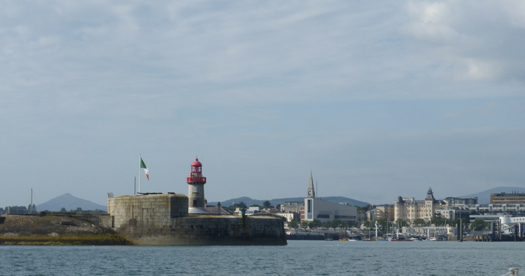
The intrusion of the new library into the Dun Laoghaire waterfront is a shock for those who haven't seen it before. Photo: W M Nixon
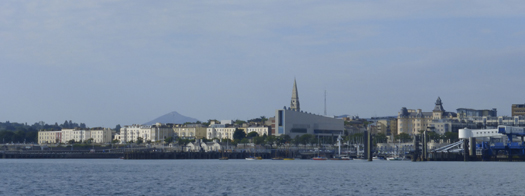
It is only from mid-harbour that you're fully aware of the damage done by the new library to Dun Laoghaire's classic waterfront. Photo: W M Nixon
Being on time is a good start. Ship's orders for visiting journos were to be aboard with the skipper and mate by 0800 in Howth Marina, and get the boat to Dun Laoghaire Marina comfortably in time for the rest of the crew coming across Dublin Bay in a fast runabout which would subsequently be used for daily commuting while the boat stayed on in Dun Laoghaire, all to be well in time for first gun at 1055hrs.
The sense of anticipation is palpable, and while the sight of the new "library and cultural centre" blighting the Dun Laoghaire waterfront was a shock for those who hadn't been it before, at the Royal Irish the happy morning mood took over again, with the place ahive with activity which is comprehensible only to regular regatta racers, and confusing for those not in the loop.
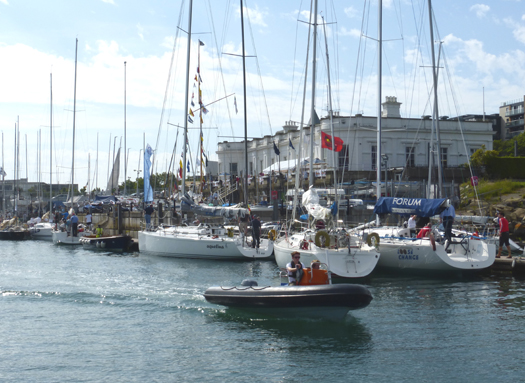
"Glad morning again". The Royal Irish YC is the perfect setting for that special pre-regatta sense of anticipation. Photo: W M Nixon
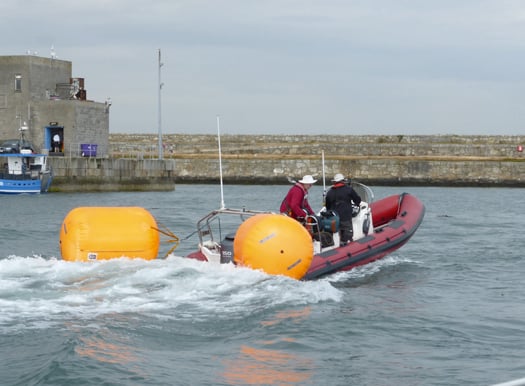
The Dun Laoghaire regatta machine swings into action with supplementary race marks heading seaward. Photo: W M Nixon
Sufficient to say that once again the mighty Dun Laoghaire regatta machine was moving smoothly into action with three different race areas being provided in the bay, and on the waterfront the club gearing up to receive a host of hungry and thirsty post-race sailors. There was a nice moment when Mark Mansfield – up in Dublin to helm John Maybury's J/109 Joker II in the Nationals – called over to say Demelza had never looked better. Other old friends to meet and greet - do other sports have quite the same level of banter as sailing? – and then out to the Bay and suss up the opposition.
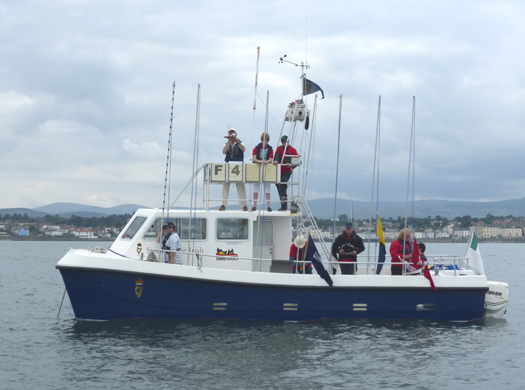
Were it not for the many volunteers manning the committee boats, an event like the ICRA Nationals simply couldn't happen. Photo: W M Nixon
There were two obvious boats in Class 6 for Demelza to beat – Jim McCann's Mustang 30 Peridot, and Sean and Kristina O'Regan's Dehler 31 Vespucci. But an unexpected addition to the lineup of ten or so boats was Frank Friel's Fist 32s5 Effex II, usually completely a cruiser and thus given a low ECHO handicap. So she was in among smaller craft, but this provided another handy target boat for the Laudan-Ennis team.
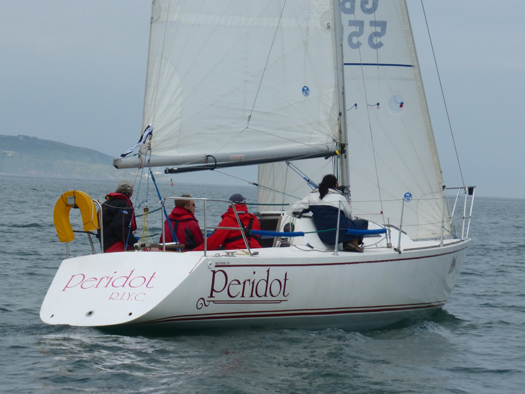
Jim McCann's Peridot was an ideal competitive match for Denmelza. Photo: W M Nixon
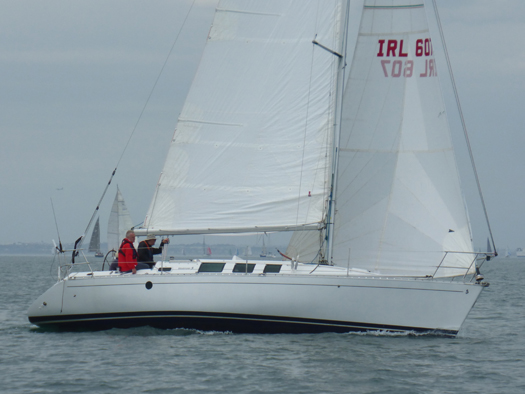
Frank Friel's Effex II took line honours in the first race. Photo: W M Nixon
And that's exactly what they are. A team. It worked beautifully in the countdown to the start, with Steffi putting the course on cockpit display and keeping tabs on time and any other messages via VHF, while Windsor was able to settle into the developing day, getting a sense of what the wind was trying to do while exchanging ideas with his afterguard of Conor Walls and Francis Ennis (Steffi's dad).
They set a hot suit of brown sails on Demelza's masthead rig, with a main from North while the genoa is Philip Watson. Within the limits of doing without spinnaker, everything is optimised and the light breeze from southeast, sometimes swinging a bit more east, is getting a useful bite to it as the first of the ebb is running southeast across our start area in the outer water of Scotsmans Bay.
As is usually the case, in these conditions on the initial beat it pays to go to the wall, closing the shore with Demelza powering along and loving it - after a good start, our skipper finds clear wind and makes the most of it. Fortunately the downwind leg become a dead run, and a masthead-rigged boat can make hay running goosewinged, but even so our lead is under increasing threat from the First 32s5, and Effex II just pips us for line honours, though on IRC Demelza has it by a mile.
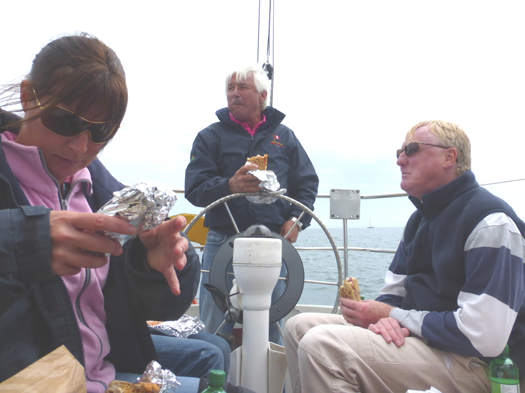
Lunch break – but definitely no alcohol until racing is finished for the day. Photo: W M Nixon
The mood over lunchtime sangers is of good work done, but more work still to do. But then that wretched new library intrudes again. You just can't get away from it. While it looks bad enough from within the harbour, from Scotsmans Bay it looks ten times worse. Out there, you can see how it has entirely blocked off a pleasant terrace of classic Dun Laoghaire waterfront houses from any enjoyment of the sunset. Compared to this new monstrosity, the Berlin Wall was surely a lovely creation.
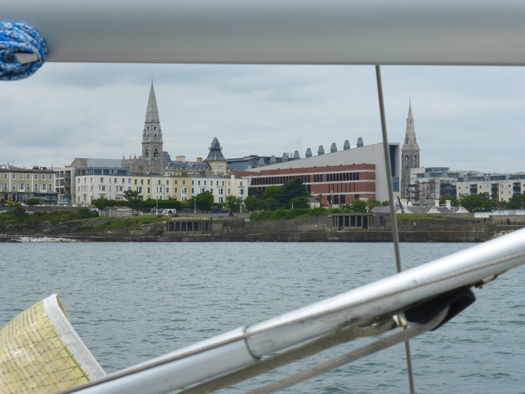
You just can't get away from it..........
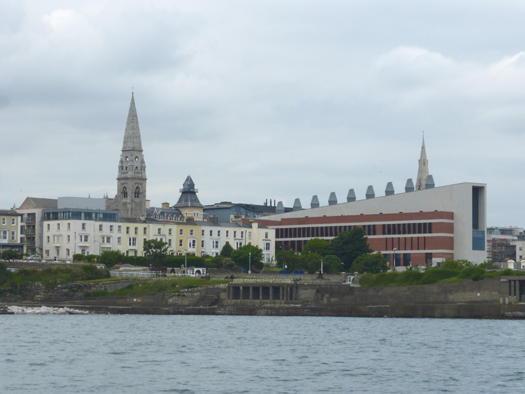
.........and farewell, Sunset Strip. The new Dun Laoghaire library has permanently blocked off the sunset for an entire terrace of houses. Photo: W M Nixon
But fortunately for our entertainment, we had a glimpse of other divisions racing, with Classes 0 and 1 running past nearby, and Denise Phelan's Ker 37 Jump Juice up from Cork doing great things on the run to make up lost ground. For the biggies as for us, the beat out of Dublin Bay was tactically fascinating as the ebb had reached full strength. Jump Juice read it to perfection, even if her winning tack on port brought her right through our starting area.
But once again the Dun Laoghaire regatta machine took it all calmly in its stride. And when we came to make our start, our skipper read it spot on, working his timing and the sluicing ebb to such an accurate level that we swept by the committee boat only a nano-second after the signal, and had congratulations from a race officer for getting it just right.
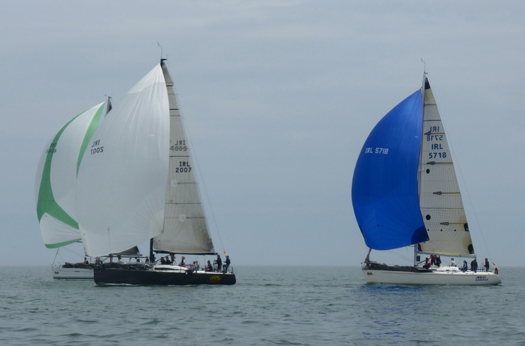
Jump Juice from Cork starting to make up lost ground on the run in Class O Photo: W M Nixon

Winning tack. Jump Juice came down the bay in impressive style hard on the wind............Photo: W M Nixon
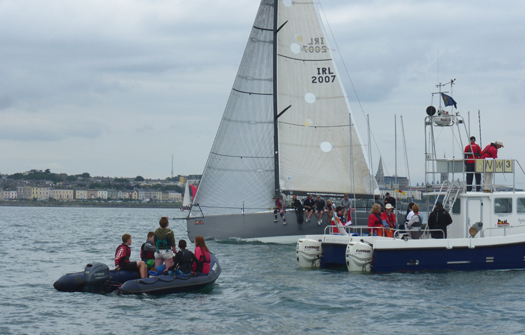
...........and her win move took her right through the Class 5 and 6 start area, but nobody batted an eyelid............Photo: W M Nixon
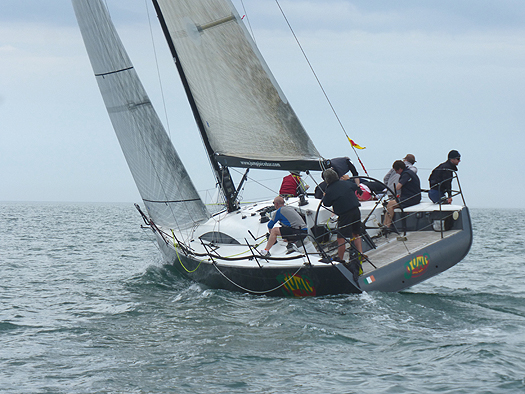
.....and it gave us an exciting glimpse of a top level racing machine. Photo: W M Nixon
That second race saw us sharing some sea space on the run with Classes 0 and 1, and as we were on starboard and interested only in maintaining our lead, some very expensive floating hardware had to throw some very neat gybes to allow the little Demelza to progress on her rightful way. But our afterguard being total boat addicts, they enjoyed nothing more than giving chapter and verse on each boat which came within range.
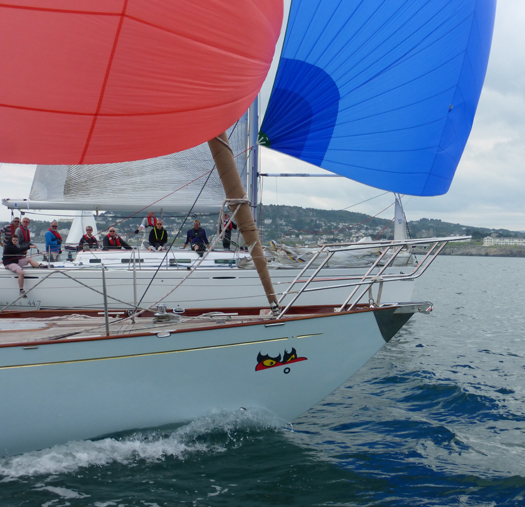
Mixing it with the heavy metal. The bows of the 54ft Soufriere and the 45ft Lively Lady after they'd neatly gybed their way out of a close encounter with the right-of-way Demelza. Photo: W M Nixon
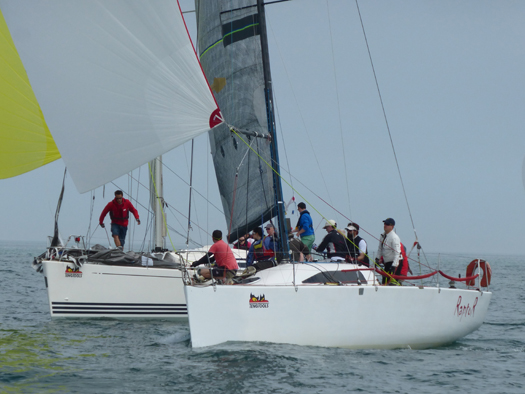
Raptor getting up to speed. She was one of the earliest Mark Mills designs, and was originally known as Aztec. Photo: W M Nixon

Tony Fox's Gringo, an A35, finds some sun on Dublin Bay. Photo: W M Nixon
The final beat saw Jim McCann with Peridot almost getting through, but sailing is a supposedly genteel sport which can show a discreetly killer side, so Windsor and Steffi were only delighted to throw a slam dunk right on top of their old friend, and go on to take line honours and their second corrected time win of the day.
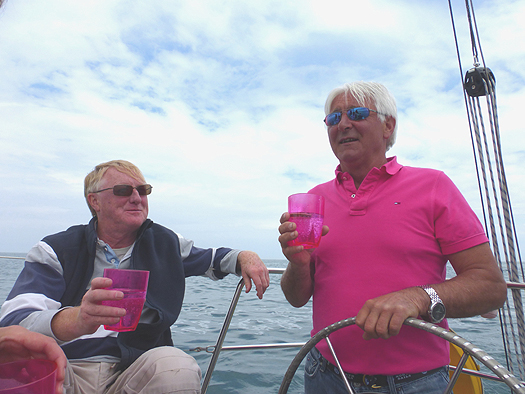
Second win, and line honours too – a bit of celebration for Conor Walls and the skipper. Photo: W M Nixon

Demelza's current success is put down to the permanent presence on board of a lucky Welsh dragon. Photo: W M Nixon

A crew of friends – racing Demelza to success are (front row, left to right) Windsor Laudan, Steffi Ennis and John Aungier, back row Francis Ennis, Conor Walls and Debbie Faherty Photo: W M Nixon
The morning's sunshine had given way to a silver-grey blandness in the weather, and to a casual observer, there might have seemed some blandness to the day's racing. But not for those taking part. I've long thought that trying to make sailing a spectator sport is a waste of time – either you take part, or you go off and watch something exciting like gardening. We'd had a marvellous day's sport, and it was followed by the usual high-octane banter at the club. The ICRA Nationals 2014 had got off to a good start. The race officers had their beloved results, with only one more race to sail to have a recognised championship. Let's hope the sun comes out today to sharpen up the sea breeze. Meanwhile, it was only after I got home I remembered it had been Friday 13th. And as for spinnakers? Well, believe me, there's life after spinnakers, there really is.
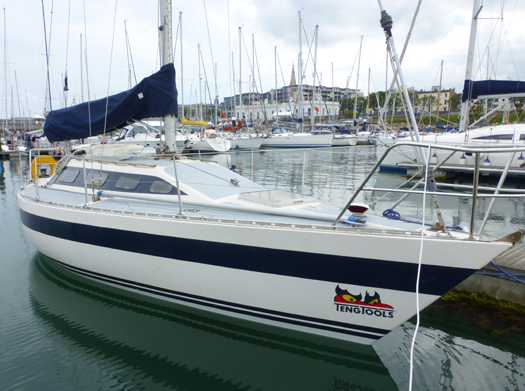
A well-loved little boat at rest after a good day's racing. In her successful 35 years, Demelza has been in only three ownerships. Photo: W M Nixon
#hyc – With only a week to go anticipation is building for the inaugural HYC Sportsboat Cup at Howth in County Dublin writes Ross McDonald.Three fleets will be battling it out over two racecourses in what is promising to be a spectacular addition to the Irish racing calendar. Racing will begin on Friday the 20th June and run over the weekend on what is the longest day of the year.
Racing will start at midday each day but the fleets will be back on dry land in time to take advantage of the late evening sun. Post sailing music and barbeques are booked for each day along with a sailing supper by HYC's new chef Jason Dunphy (ex Rolys, Conrad and more) on offer for Friday evening. On Saturday evening there will be a midsummer celebration with a dinner dance organised so the club will certainly be a lively spot.
The 1720 Europeans will be held as part of the event which is drawing an international flavour to the racing, with boats travelling from the UK to compete for the title. This is the first time in several years that this event has been held out of the 1720 stronghold of Cork and it is giving the boats from Dublin a new lease of life. Entries are coming in from the host club as well as The Irish, The George and the INSC in Dun Laoghaire. That's not to mention all of the old heads that are popping up on some of the regulars boats to rekindle their love of the 1720 and impart some local knowledge while at it. Boats are starting to arrive this weekend with the aim of familiarising themselves with race area.
The J24 fleet will be hotly contested with several seasoned campaigners and previous regional and national champions battling it out for the title. The fleet have lots of experience racing in Howth and are returning to the battleground of last summer's Worlds and the Europeans from 2011.
The J80s will be populated with lots of notable sailors across a wide range of ages. From young Oppie champions to world match racers and everything in between this racing is promising to be memorable. With all the boats rigged and tuned identically this fleet will come down to nothing but the sailors skills.
As well as awarding fleet prizes a perpetual trophy will be awarded to the overall event winner. The details of how it will be decided will be revealed in the SI's.
There is still time to get an entry in. You can enter online here
Howth Yacht Club Double-Handed Yacht Race Challenge to Feature Kish, Rockabill & Lambay
#hyc – Howth Yacht Club will run an open double-handed race on Saturday, August 23, 2014 for both spinnaker cruiser classes and white sail cruiser classes. The course will use the Kish Lighthouse, Rockabill lighthouse and Lambay and will start and finish at Howth's East pier. The course will be approximately 40 miles with a start time of 10am and hopeful finish time of late afternoon.
Double handed sailing is the fastest growing fleet within the RORC race calendar and so this challenge will give a taste of shorthanded sailing to HYC crews and hopefully will attract visitors from other local clubs.
Preparation and participation in the HYC Double handed Challenge is a great way for competitors to build shorthanded sailing skills and have a safe fun passage.
So put this in your diary, pick a crew (just one) and go for a practice sail. Entry forms, Notice of Race and Sailing Instructions will be posted soon.































